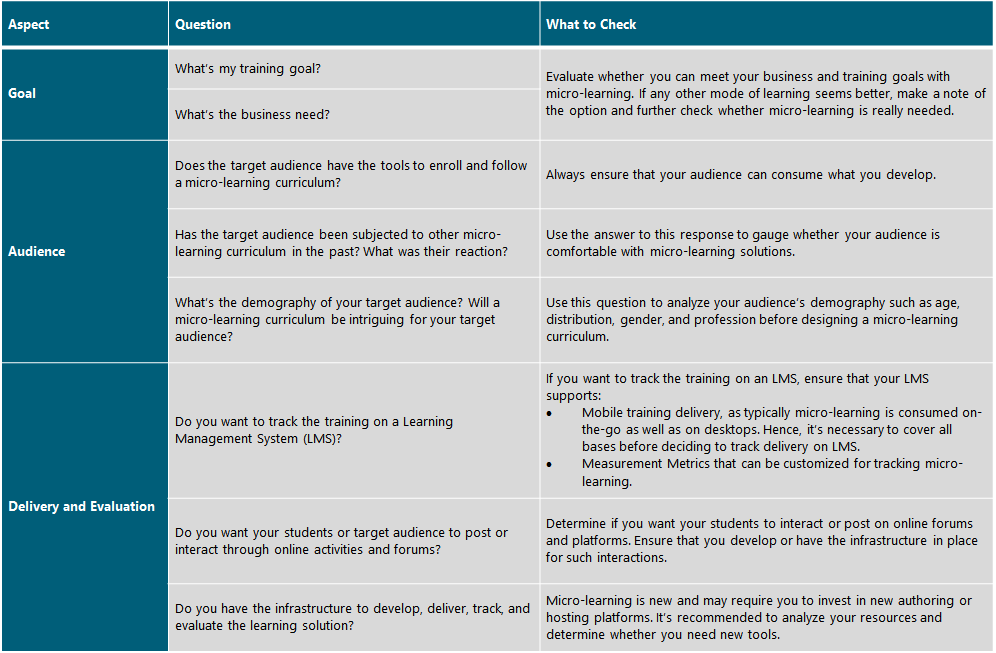
Learning is a lifelong process. We are constantly learning new things daily, be it through web searches, Social Media, or even by observing others do their jobs. For most of us, knowledge acquisition occurs in small pieces, through unstructured searches and reading on the Web. A majority of this learning happens in small chunks through sources that are not designed as formal courses, but still impart knowledge.
This trend gives us Instructional Designers, an important training need indicator for the modern audience:
[info ]Our learners have evolved. They may still need structured one- or three-hour long eLearning sessions or workshops that last several hours or days. However, they also want quick packets of on-demand learning that continually enhance their knowledge and skills.[/info]
Such small, consumable on-demand learning packets have become popular and supply the learning that satiates the training demand.
What is micro-learning?
Micro-learning is the process of learning in small, digestible and manageable chunks, with focused and precise information. It is based on short-term learning activities, lesson plans, projects, and assignments. The focus is on one objective rather than a broad subject, that is, the topic is broken down into smaller information, and learners can access this information whenever they need it or even on-the-go. Thus, in micro-learning, lessons are short with no defined duration, and can be learned anytime, anywhere, at one’s own pace, via any modality. You are micro-learning, for example, when you watch a YouTube video on how to install a new software on your PC or how to bake cookies; when you read a blog to understand comma usage; when you listen to a podcast on project management; or when you ask a colleague for advice, etc.
When to use it?
The use of micro-learning is growing. It can be used to demonstrate and develop skills, gain information, understand concepts, explain parts of a process or steps, and increase employee engagement. It can be more effective when used to reinforce what has already been taught. For example, after a long training session, a facilitator can send short write-ups or tips from the training session. Thus, it can be more successful when used with blended teaching method. However, avoid using micro-learning when a learner is moving from novice to fluency.
Training Needs Analysis for Micro-Learning
If you develop a micro-learning curriculum, but if it’s not needed or doesn’t meet the learning goals, then you’ll just end up creating something redundant, which doesn’t do justice to your efforts, learner’s time, or company’s money. So, it’s essential to perform a thorough Training Needs Analysis to evaluate whether micro-learning will be a feasible solution to your learning and business problems. Here are some questions that you should answer before developing micro-learning:
Micro-Learning and Instructional Design Strategies
Studies have shown that micro-learning is engaging, easy to implement, and cost-effective, and has higher retention levels if implemented to match an appropriate Training Need. It helps learners immediately access the knowledge they need. Moreover, it supports different learning styles with a variety of formats. To start, break the course content into topics, then sub-topics, and finally, the sub-topics into individual learning objectives. Following are some best practices for creating micro-learning:
- Chunk and design content properly
- Target for clarity and quality of content
- Focus on one objective
- Keep it short and simple
- Make it interesting and engaging
- Cater to a variety of learning styles and learning platforms
- Create learning activities that can be consumed within a maximum of 10 minutes (such as, video tutorials, blogposts, or podcasts)
How to measure its effectiveness?
Micro-learning is like putting old wine in a new bottle; that is, it’s still training, but it’s taking a new form. So, the traditional methods of training effectiveness and evaluation are still relevant. However, you need to adapt them to measure effectiveness and evaluate micro-learning. For example, let’s consider Surveys: as a learner, would you answer a feedback survey about the quality and effectiveness of 10-minute micro-learning video? What about if a curriculum/training is composed of 15 ten-minute videos – would you want to answer 15 surveys that are sent to you at the end of each video? Most of us would get irate when asked to answer surveys frequently. Hence, as Instructional Designers, we need to adapt the old methods of measuring to the new mode of training. For example, for the second scenario, you can consider sending a survey to learners after they watch all 15 videos.
In addition, consider measuring other metrics that Marketers use. For example, if you write a blog as a part of your learning curriculum, measure how long a reader/learner stays on your Web Page. Or, if you have created a video, measure how many of your learners are watching the video end-to-end.
So, to sum up, micro-learning is bite-sized learning created to satiate immediate learning requirements. Recent studies have shown that our attention span is getting shorter, and so short and focused snippets of information is the key to avoid information overload. With the help of modern technologies such as, smartphones and tablets, micro-learning can be an effective tool for learning anytime, anywhere, at own pace.




